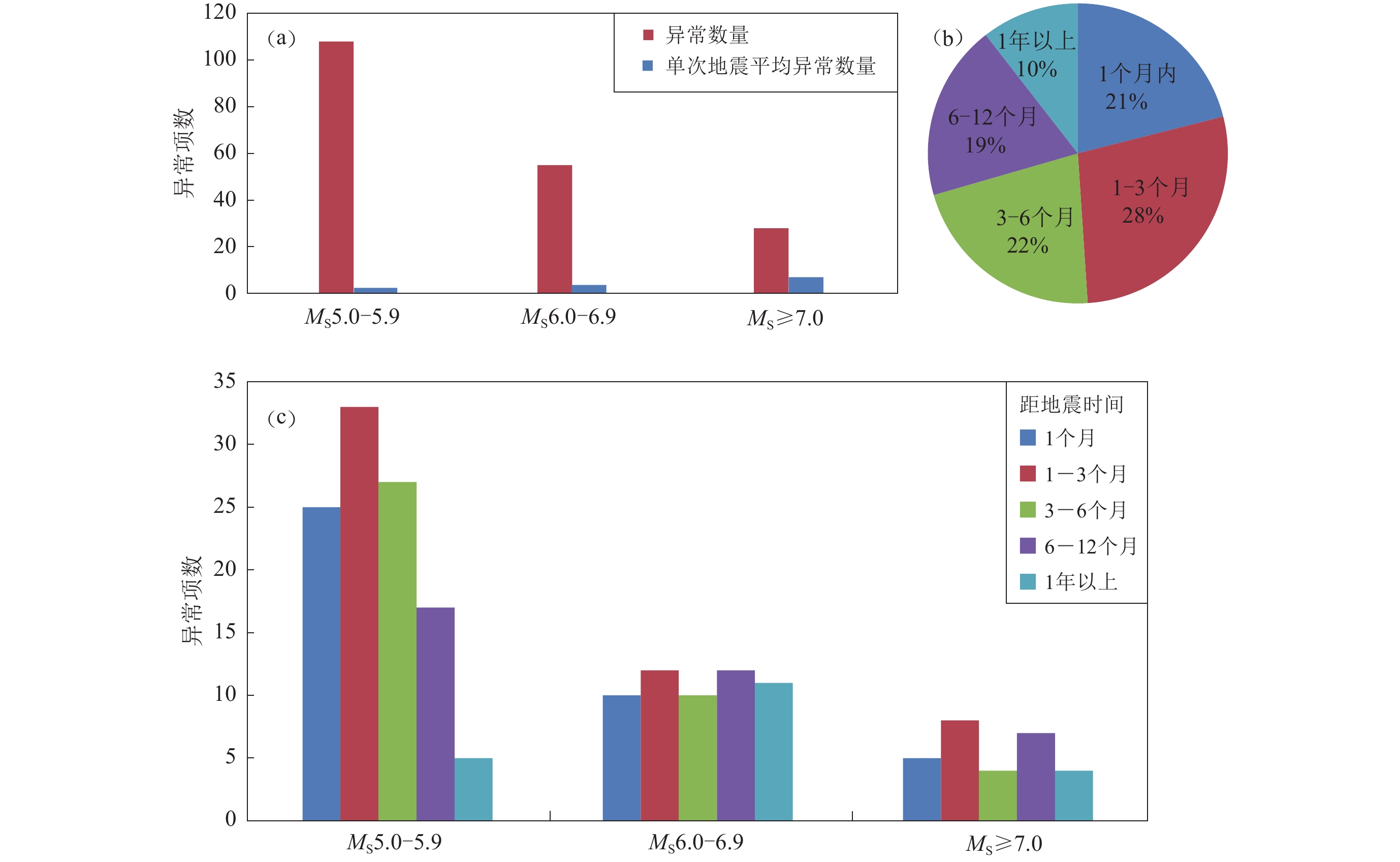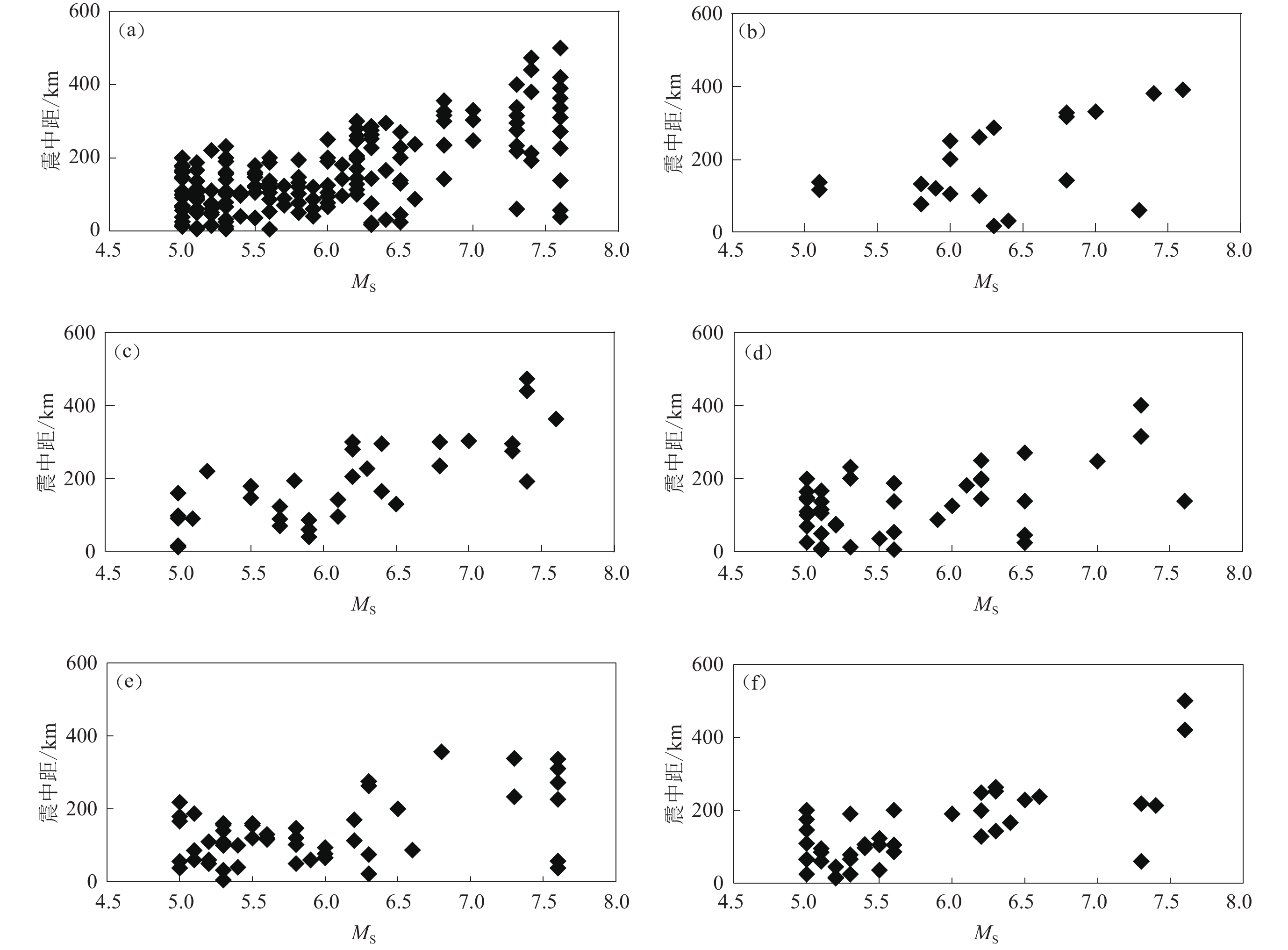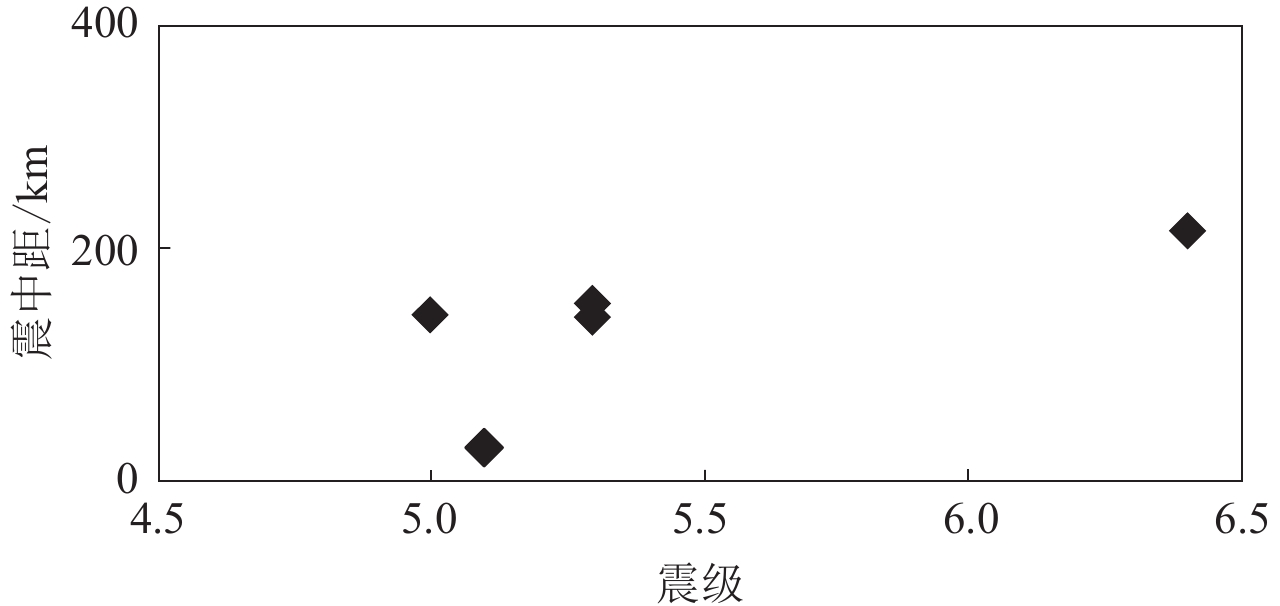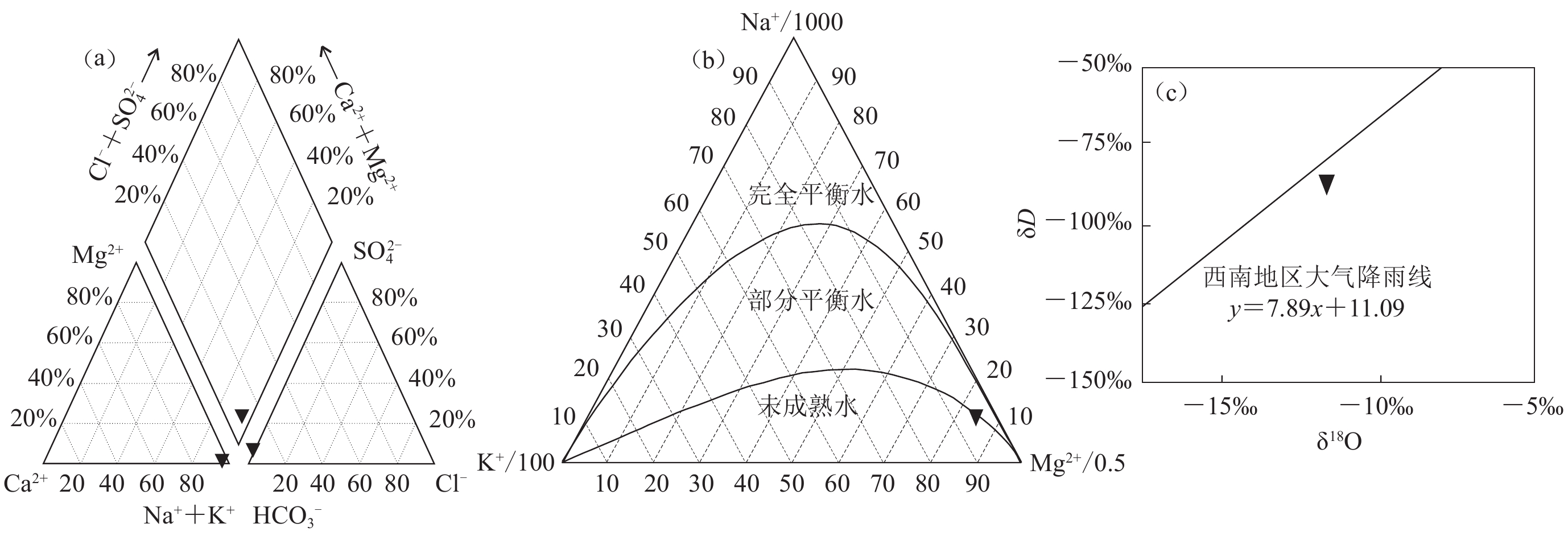Statistical characteristics analysis on the relationship between radon anomalies and earthquakes in Yunnan region
-
摘要:
通过梳理1976—2022年震例总结报告中云南地区73组MS≥5.0地震的氡测项异常,对其特征予以统计分析。结果表明:73组地震中有63组震前出现水氡异常,震前6个月内的短期异常占总异常的71%,3个月内的短临异常占总异常的49%,地震前3个月异常数量增加显著;震级越大,异常分布越远离震中,震前1个月新出现的异常大部分集中在震中附近。相对而言,由于测点位置和观测技术方面的原因,气氡积累的震例远远少于水氡,但具有短期异常占比较高的优势。随着气氡观测技术的不断改进和观测经验的不断积累,其捕捉地震异常信息的能力也将会不断提升。
Abstract:This paper is based on the summary report of Yunnan earthquake cases from 1976 to 2022.It sorts out 73 sets of earthquakes with M≥5.0 one by one, and extracts abnormal information of radon measurement items before earthquakes, then explores the characteristics of radon precursory anomalies.The results are as follows:
1) There were 190 water radon anomalies among 63 out of 73 earthquakes. There were a large number of anomalies and a low earthquake missing rate, indicating that water radon observation have good monitoring capability for regional earthquakes. However, the proportion of gas radon anomalies is relatively low by comparison. In our earthquake cases, there were five gas radon anomalies among only four out of 39 earthquakes, showing a higher earthquake missing rate. But as for the measurement sites with good basic conditions, gas radon anomalies have a high repetition rate, and correspond well to earthquakes. Among the five radon anomalies accumulated in historical earthquake cases, three of them were observed by gas radon well Gaoda.
2) The water radon anomalies appeared mainly within six months before earthquakes with M≥5.0, accounting for 71% of the total anomalies. Among them, anomalies within three months account for 49% of the total anomalies. Starting from the year before the M5.0−5.9 earthquakes, the number of water radon anomalies in different stages increased significantly. One month before the earthquake, most of the anomalies showed a turning point and then returned to normal level, with a decrease in the number of anomalies. On the other hand, there are not many earthquake cases with abnormal gas radon concentration, but all anomalies are within six months before earthquakes, of which 80% are within three months.
3) The spatial distribution of water radon anomalies is different before earthquakes with different magnitudes. Before the earthquakes with magnitude 5.0−5.9, the closer to the time of the earthquake occurrence, the more anomalies are concentrated near the epicenter. During the period of more than six months prior to the earthquake, the anomalies are scattered in space. Starting from six months before the quake, the number of anomalies within a 100 km radius of the epicenter gradually increased. Starting from one month before the earthquake, most of the anomalies outside the 100 km radius of the epicenter showed a turning point and then returned to normal level, the anomalies are concentrated near the epicenter, which can provide reference for location tracking. Before earthquakes with magnitude 6.0 or above, more water radon anomalies appeared in the areas far from the epicenter, which were relatively scattered. Such anomalies appearing in a large area may indicate that the stress levels in the entire field were increasing. In this state, potential risk of a major earthquake is likely higher. There are relatively few earthquake cases with gas radon anomalies, and the spatial distribution characteristics are not obvious.
This paper is based on the summary report of earthquake cases, which shows that there are more anomalies in water radon than in gas radon, and the prediction effect is better than that of gas radon. This is consistent with the practical results reflected by the technical personnel after actual use of the data. Several possible main reasons are: Firstly, the observation sites of water radon are more focused on deep circulating hot spring water, which is more likely to reflect deep tectonic activity. Secondly, the observation methods of water radon and gas radon are different. Water radon is observed by manually collecting water samples and detecting, and the technology is relatively stable. However, gas radon is observed automatically, but the stability of the devices for extracting radon gas from water and collecting it has not been fully solved, and the technology from gas collection to automatic detection process is not mature yet. In addition, the efficiency and stability of degassing directly affect the observation quality of data. Thirdly, at some observation sites the escaping gas was extracted from static water level wells to observe the radon concentration, which is difficult to reflect information from deep Earth.
Overall, the differences in the effectiveness of water radon and gas radon data in earthquake prediction are caused by factors such as the location of measurement sites and observation techniques. At present, the observation data of gas radon in Yunnan has not yet achieved the effect of water radon in earthquake prediction. However, gas radon observation has advantages that water radon does not have, such as higher automation, faster transmission, higher data sampling rates. Technology-oriented and intelligentization are the main development tendency of radon observation. With the improvement of observation technology and the accumulation of observation experience, the ability to capture seismic anomaly will also be strengthen.
-
Keywords:
- radon /
- seismic anomaly /
- earthquake prediction /
- statistical characteristics
-
1 ① 樊文杰,贺素歌,赵小艳,胡小静,刘强,王光明, 张潜,李智蓉, 刘自凤,孙楠,彭关灵, 李永莉。2021。2021年5月21日云南省漾濞6.4级地震。昆明:云南省地震局:1−76。2 ② 贺素歌,赵小艳,钱晓东,刘自凤,李智蓉,张潜,刘强。2021。2021年6月10日双柏MS5.1地震。昆明:云南省地震局:1−69。3 ③ 张潜,赵小艳,贺素歌,樊文杰,刘翔,张翔。2021。2021年6月12日云南省盈江5.0级地震。昆明:云南省地震局:1−47。4 ④ 罗睿洁,李利波,张天宇,王光明,刘自凤,张潜,刘强,樊文杰,付虹。2022。2022年1月2日宁蒗MS5.5地震。昆明:云南省地震局:1−80。5 ⑤ 刘强,樊文杰,高文斐,曾宁。2022。2022年11月19日云南红河5.0级地震。昆明:云南省地震局:1−65。 -
图 3 水氡异常与地震关系统计分布图
(a) 不同震级档异常数量分布;(b) 地震前不同阶段异常数量占比;(c) 地震前不同震级档、不同时段异常数量分布
Figure 3. Statistical distribution chart of the relationship between water radon anomalies and earthquakes
(a) Distribution of anomalies in different magnitude ranges;(b) The proportion of anomalies in different stages before earthquakes;(c) Distribution of anomalies in different ranges and different time periods before earthquakes
图 6 出现水氡异常的观测点的震中距与震级关系统计分布图
(a) 所有地震;(b) 震前1年以上;(c) 震前6—12个月;(d) 震前3—6个月;(e) 震前1—3个月;(f) 震前1个月内
Figure 6. Statistical distribution chart of the relationship between the distance from the observation point of water radon anomaly to the epicenter and the magnitude of the earthquake
(a) All earthquakes;(b) More than 1 year before the earthquake;(c) 6—12 months before the earthquake;(d) 3—6 months before the earthquake;(e) 1—3 months before the earthquake; (f) One month before the earthquake
图 8 高大井水体水化学分析
(a) Piper图;(b) Na-K-Mg三角图;(c) 氢氧同位素组成 (胡小静等,2018)
Figure 8. Hydrochemical analysis of groundwater in Gaoda well
(a) Piper diagram;(b) The triangle diagram of Na-K-Mg;(c) Hydrogen and oxygen isotopes (Hu et al,2018)
-
车用太,鱼金子,刘五洲. 1997. 水氡异常的水动力学机制[J]. 地震地质,19(4):353–357. Che Y T,Yu J Z,Liu W Z. 1997. The hydrodynamic mechanism of water radon anomaly[J]. Seismology and Geology,19(4):353–357 (in Chinese).
陈立德,付虹,邬成栋. 2008. 强震短临前兆异常共性特征的物理基础[J]. 地震研究,31(2):99–102. Chen L D,Fu H,Wu C D. 2008. Physical bases of common characteristics of short-term and impending-earthquake precursor anomalies before a strong earthquake[J]. Journal of Seismological Research,31(2):99–102 (in Chinese).
陈棋福. 2002a. 中国震例(1992—1994)[M]. 北京:地震出版社:1−399. Chen Q F. 2002a. Earthquake Cases in China (1992−1994)[M]. Beijing:Seismological Press:1−399 (in Chinese).
陈棋福. 2002b. 中国震例(1995—1996)[M]. 北京:地震出版社:1−489. Chen Q F. 2002b. Earthquake Cases in China (1995−1996)[M]. Beijing:Seismological Press:1−489 (in Chinese).
陈棋福. 2003. 中国震例(1997—1999)[M]. 北京:地震出版社:1−468. Chen Q F. 2003. Earthquake Cases in China (1997−1999)[M]. Beijing:Seismological Press:1−468 (in Chinese).
陈棋福. 2008. 中国震例(2000—2002)[M]. 北京:地震出版社:1−570. Chen Q F. 2008. Earthquake Cases in China (2000−2002)[M]. Beijing:Seismological Press:1−570 (in Chinese).
付虹,苏有锦,刘丽芳. 2008a. 云南地区地震预报的进展及震源参数用于地震预报的尝试[C]//中国地震预报探索:梅世蓉先生80华诞论文集. 北京:地震出版社:160−168. Fu H,Su Y J,Liu L F. 2008a. Progress in earthquake prediction and attempts to use seismic source parameters for earthquake prediction in Yunnan region[C]//Exploration of Earthquake Prediction in China:Collected Papers in Commemoration of Mr. Mei Shirong’s 80th Birthday. Beijing:Seismological Press:160−168 (in Chinese).
付虹,李永莉,赵小艳,刘丽芳. 2008b. 云南M≥5地震震前异常的统计特征[J]. 地震研究,31(4):335–339. Fu H,Li Y L,Zhao X Y,Liu L F. 2008b. Statistical characteristics of the anomalies before the M≥5 earthquakes in Yunnan region[J]. Journal of Seismological Research,31(4):335–339 (in Chinese).
高小其,何镧,刘佳琪,蒋雨函,樊春燕,李庆,王小娟,陈其峰,汪世仙,李志鹏,朱成英. 2021. 地下流体台网数字化气体观测新型脱气-集气装置的研制与应用[J]. 地震研究,44(4):550–563. Gao X Q,He L,Liu J Q,Jiang Y H,Fan C Y,Li Q,Wang X J,Chen Q F,Wang S X,Li Z P,Zhu C Y. 2021. Development and application of a new type of degassing,gas-gathering device for digital gas observation of the underground fluid network[J]. Journal of Seismological Research,44(4):550–563 (in Chinese).
国家地震局科技监测司. 1995. 地震地下水手册[M]. 北京:地震出版社:135−229. Department of Science and Technology Monitoring,State Seismological Bureau. 1995. Earthquake Groundwater Manual[M]. Beijing:Seismological Press:135−229 (in Chinese).
胡小静,付虹,李琼. 2018. 滇南地区近期水位趋势上升异常机理初探[J]. 地震学报,40(5):620–631. Hu X J,Fu H,Li Q. 2018. Preliminary study on abnormal mechanism of groundwater level rising in southern Yunnan[J]. Acta Seismologica Sinica,40(5):620–631 (in Chinese).
蒋海昆. 2014. 中国震例(2003—2006)[M]. 北京:地震出版社:1−818. Jiang H K. 2014. Earthquake Cases in China (2003−2006)[M]. Beijing:Seismological Press:1−818 (in Chinese).
蒋海昆. 2019. 中国震例(2014—2015)[M]. 北京:地震出版社:1−722. Jiang H K. 2019. Earthquake Cases in China (2014−2015)[M]. Beijing:Seismological Press:1−722 (in Chinese).
孔庆敏,王广才,史浙明. 2018. 云南地区震前地下流体异常特征统计分析[J]. 地震学报,40(5):632–645. Kong Q M,Wang G C,Shi Z M. 2018. Statistical analysis of pre-seismic anomalous characteristics of subsurface fluids in Yunnan region[J]. Acta Seismologica Sinica,40(5):632–645 (in Chinese).
刘永涛. 2009. 云南省龙陵县邦腊掌温泉水文地球化学与间歇喷泉研究[D]. 北京:中国地质大学(北京):1−63. Liu Y T. 2009. A Study of Hydrochemistry and Geyser of Thermal Groundwater in the Banglazhang Geothermal Field in Longling,Yunnan[D]. Beijing:China University of Geosciences (Beijing):1−63 (in Chinese).
刘轶男. 2017. 丰满台水氡异常特征分析[J]. 华北地震科学,35(4):80–83. Liu Y N. 2017. Anomaly characteristics of groundwater radon in Fengman seismic station[J]. North China Earthquake Sciences,35(4):80–83 (in Chinese).
刘耀炜,任宏微. 2009. 汶川8.0级地震氡观测值震后效应特征初步分析[J]. 地震,29(1):121–131. Liu Y W,Ren H W. 2009. Preliminary analysis of the characteristics of post-seismic effect of radon after the Wenchuan MS8.0 earthquake[J]. Earthquake,29(1):121–131 (in Chinese).
梅世蓉,冯德益,张国民,朱岳清,高旭,张肇诚. 1993. 中国地震预报概论[M]. 北京:地震出版社:1−300. Mei S R,Feng D Y,Zhang G M,Zhu Y Q,Gao X,Zhang Z C. 1993. Introduction to Earthquake Prediction in China[M]. Beijing:Seismological Press:1−300 (in Chinese).
邵志刚. 2022. 中国震例(2018—2020)[M]. 北京:地震出版社:1−1226. Shao Z G. 2002. Earthquake Cases in China (2018−2020)[M]. Beijing:Seismological Press:1−1226 (in Chinese).
晏锐. 2018. 云南省龙陵邦腊掌温泉水文变化特征与机理研究[D]. 北京:中国地质大学(北京):1−102. Yan R. 2018. Study on the Characteristics and Mechanism of Hydrological Changes at Banglazhang Hot Spring Site in Longling County,Yunnan Province[D]. Beijing:China University of Geosciences (Beijing):1−102 (in Chinese).
云南省地震局. 2005. 云南省地震监测志[M]. 北京:地震出版社:366−367. Earthquake Administration of Yunnan Province. 2005. Yunnan Earthquake Monitoring[M]. Beijing:Seismological Press:366−367 (in Chinese).
中国地震局监测预报司. 2002. 地下流体数字观测技术[M]. 北京:地震出版社:32−54. Department of Monitoring and Forecasting,China Earthquake Administration. 2002. Underground Fluid Digital Observation Technology[M]. Beijing:Seismological Press:32−54 (in Chinese).
张炜,林颐乐. 1978. 地震前兆水化特征及讨论[J]. 地震战线,(6):24–31. Zhang W,Lin Y L. 1978. Hydration characteristics and discussion on earthquake precursor[J]. Earthquake Front,(6):24–31 (in Chinese).
张肇诚. 1990a. 中国震例(1976—1980)[M]. 北京:地震出版社:1−411. Zhang Z C. 1990a. Earthquake Cases in China (1976−1980)[M]. Beijing:Seismological Press:1−411 (in Chinese).
张肇诚. 1990b. 中国震例(1981−1985)[M]. 北京:地震出版社:1−283. Zhang Z C. 1990b. Earthquake Cases in China (1981−1985)[M]. Beijing:Seismological Press:1−283 (in Chinese).
张肇诚,郑大林,罗咏生. 1991. 中国大陆地震震例及综合预报判据和指标研究[G]//地震预报方法实用化研究文集(综合预报专辑). 北京:地震出版社:185−216. Zhang Z C,Zheng D L,Luo Y S. 1991. Study on criteria and indicators for comprehensive earthquake prediction in Chinese mainland[G]//Collection of Practical Research Papers on Earthquake Prediction Methods (Comprehensive Forecast Collection). Beijing:Seismological Press:185−216 (in Chinese).
张肇诚. 1999. 中国震例(1986—1988)[M]. 北京:地震出版社:1−378. Zhang Z C. 1999. Earthquake Cases in China (1986−1988)[M]. Beijing:Seismological Press:1−378 (in Chinese).
张肇诚. 2000. 中国震例(1989—1991)[M]. 北京:地震出版社:1−447. Zhang Z C. 2000. Earthquake Cases in China (1989−1991)[M]. Beijing:Seismological Press:1−447 (in Chinese).
张肇诚,陈棋福,郑大林. 2013. 震例总结研究探讨[M]. 北京:地震出版社:35−36. Zhang Z C,Chen Q F,Zheng D L. 2013. Summary and Study of Earthquake Cases[M]. Beijing:Seismological Press:35−36 (in Chinese).
郑兆苾,张国民,何康,张来平. 2006. 中国大陆地震震例异常统计与分析[J]. 地震,26(2):29–37. Zheng Z B,Zhang G M,He K,Zhang L P. 2006. Statistics and analyses of the anomalies of earthquake cases in China’s mainland[J]. Earthquake,26(2):29–37 (in Chinese).
Cicerone R D,Ebel J E,Britton J. 2009. A systematic compilation of earthquake precursors[J]. Tectonophysics,476(3/4):371–396.
Sugisaki R,Ito T,Nagamine K,Kawabe I. 1996. Gas geochemical changes at mineral springs associated with the 1995 southern Hyogo earthquake (M=7.2),Japan[J]. Earth Planet Sci Lett,139(1/2):239–249.




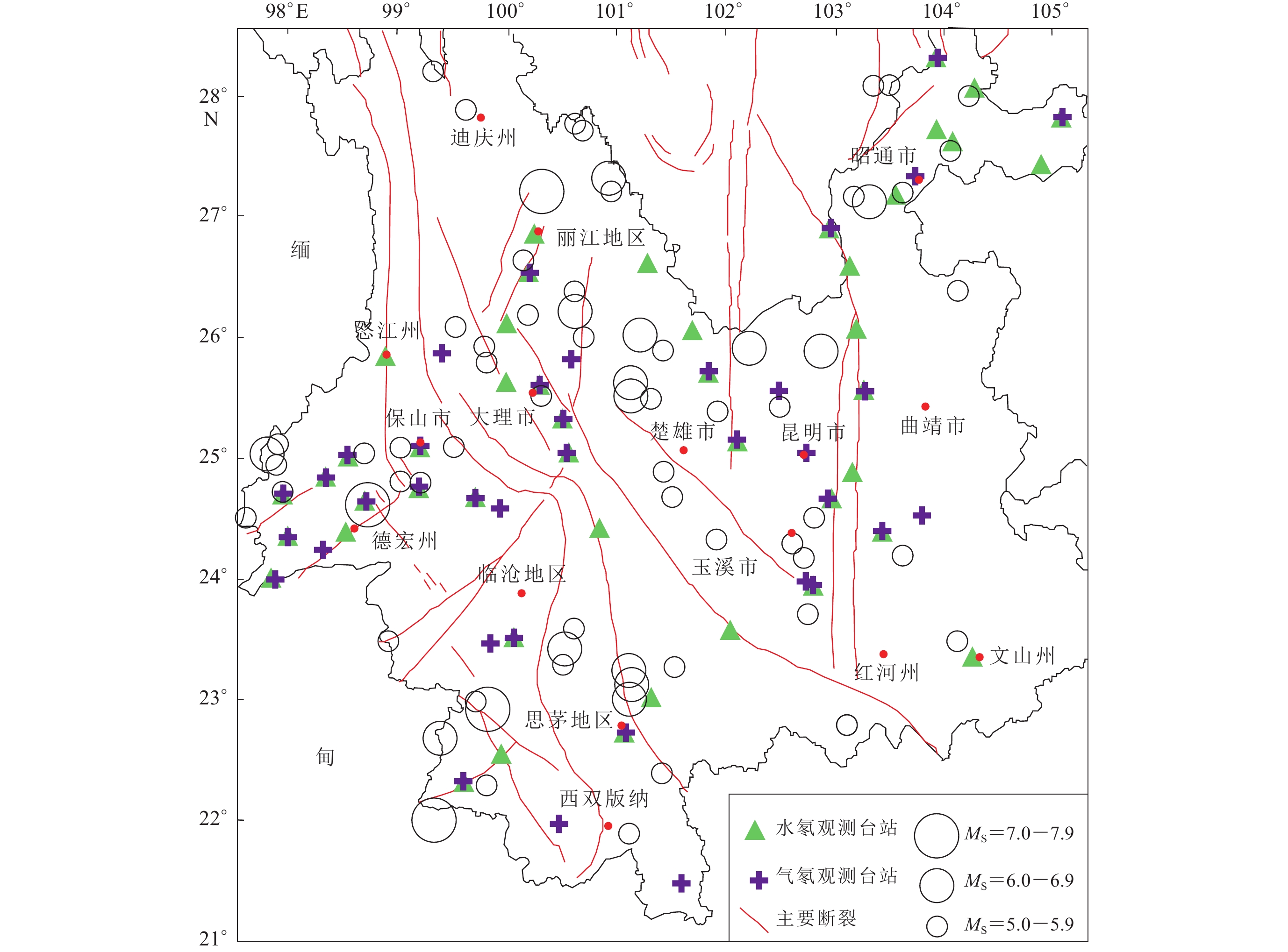
 下载:
下载:

